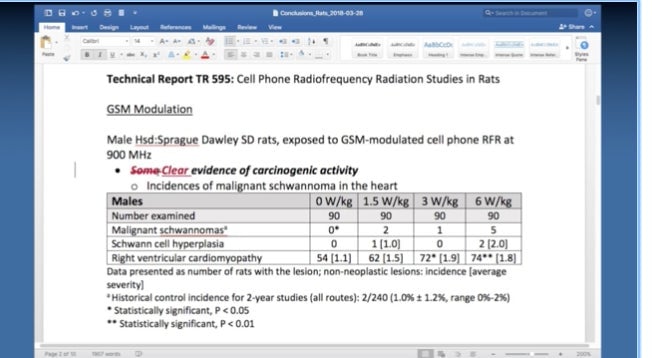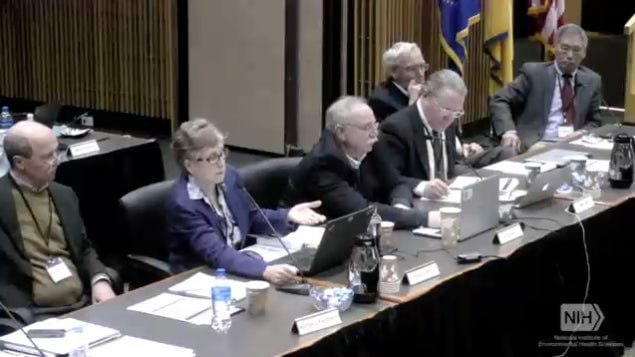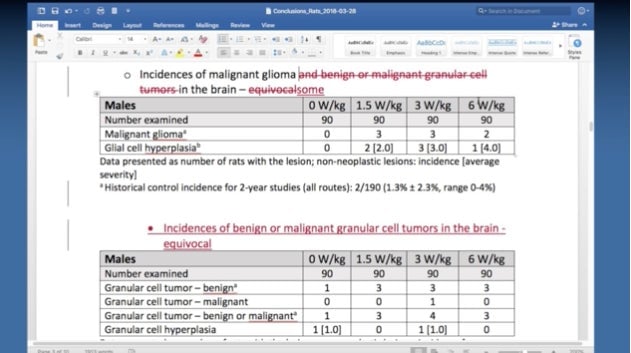We now have the first clear evidence cell phone radiation can cause cancer in rats
This week, following three days of live-broadcast peer review sessions, experts concluded that a pair of federal studies show “clear evidence” that cell phone radiation caused heart cancer in male rats.


This week, following three days of live-broadcast peer review sessions, experts concluded that a pair of federal studies show “clear evidence” that cell phone radiation caused heart cancer in male rats.
This substantially changes the debate on whether cell phone use is a cancer risk. Up until this point, the federal government and cell phone manufacturers operated on the assumption that cell phones cannot by their very nature cause cancer, because they emit non-ionizing radiation. Whereas ionizing radiation—the kind associated with x-rays, CT scans, and nuclear power plants, among others—definitely causes cancer at high enough doses, non-ionizing radiation was believed to not emit enough energy to break chemical bonds. That meant it couldn’t damage DNA, and therefore couldn’t lead to mutations that cause cancer.
But the pair of studies by the US National Toxicology Program found “clear evidence” that exposure to radiation caused heart tumors in male rats, and found “some evidence” that it caused tumors in the brains of male rats. (Both are positive results; the NTP uses the labels “clear evidence,” “some evidence,” “equivocal evidence” and “no evidence” when making conclusions.)
Tumors were found in the hearts of female rats, too, but they didn’t rise to the level of statistical significance and the results were labeled “equivocal;” in other words, the researchers couldn’t be sure the radiation is what caused the tumors.
The next scientific step will be to determine what this means for humans. The peer-reviewed papers will be passed on to the US Food and Drug Administration, which is responsible for determining human risk and issuing any guidelines to the public, and the Federal Communications Commission, which develops safety standards for cell phones. The FDA was part of the group of federal agencies who commissioned the studies back in the early 2000s.

Ronald Melnick, the NTP senior toxicologist who designed the studies (and who retired from the agency in 2009), says it’s unlikely any future study could conclude with certainty that there is no risk to humans from cell phone use. “I can’t see proof of a negative ever arising from future studies,” Melnick says.
He believes the FDA should put out guidance based on the results of the rat studies. “I would think it would be irresponsible to not put out indications to the public,” Melnick says. “Maintain a distance from this device from your children. Don’t sleep with your phone near your head. Use wired headsets. This would be something that the agencies could do right now.”
A re-evaluation of the data
When the draft results of the papers were published earlier this year, all results were labeled “equivocal,” meaning the study authors felt the data weren’t clear enough to determine if the radiation caused the health effects or not. But the panel of peer reviewers (among them brain and heart pathologists, toxicologists, biostaticians, and engineers) re-evaluated the data and upgraded several of the conclusions to “some evidence” and “clear evidence.”

Peer review is a vital part of any scientific study; it brings several more lifetimes of expertise into the room to rigorously check a study for any weak points. Melnick calls the peer reviewers’ choice to change some conclusions an unusual move; “It’s quite uncommon that the peer review panel changes the final determination,” he says, noting if anything, he’s seen peer reviewers downgrade findings, not upgrade them. “Typically when NTP presents their findings, the peer review almost in all cases goes along with that.” In this case, the peer reviewers felt the data—when combined with their knowledge of the cancers and with the study design itself—was significant enough to upgrade several of the findings.
The peer reviewers did have some quibbles with the study; some wished it could have lasted longer (the rodents were exposed to radiation for two years) to catch later-developing tumors, for example, but others on the panel noted that the longer a rodent lives, the more likely it is to develop tumors regardless of radiation, making it harder to find the signal in the noise. Others wanted the researchers to have dissected the rodent brains more than they did, to seek hard-to-find tumors. But they noted that science is an iterative process; the study wasn’t perfect, but it’s better than anything that’s been done so far.

Overall, the peer reviewers commended the study for its rigorous design and execution. George Corcoran, the chair of the department of pharmaceutical sciences at Wayne State University who sat on the panel, says the study was of a “gold standard for design and conduct” and was “comprehensive and robust throughout.”
What the studies actually found
The papers found that, in male rats, there was “clear evidence” that exposure to cell phone radiation increased risk for a rare type of malignant tumor called schwannoma in the connective tissues that surround nerves in the heart (they found “equivocal” evidence for the same thing in female rats). They also found “some evidence” that the radiation caused malignant glioma—a type of brain cancer affecting glial cells—in the male rats.
There was also “equivocal” evidence that it raised the risk of heart conditions, and led to evidence of DNA damage. Baby rats born to mothers during the trial had lower birth weights. The scientists also found a statistically significant increase in lymphoma (cancer of the lymph nodes) among female mice and heightened rates of liver cancer in the male mice. All those findings were labeled “equivocal.”
As we’ve noted before, animal studies can’t perfectly replicate human cell phone use; you can’t make a rat hold a tiny mobile phone, or put it in its pocket, for example.
But the results of these two rat studies align with those of the biggest cell phone-radiation human study to date, INTERPHONE. The INTERPHONE study, published in 2011, was a coordinated effort by researchers at 16 institutions across 13 countries, and found that the heaviest mobile phone users were more likely to develop glioma—the same type of brain cancer the NTP study found in the male rats. “So there’s a concordance between the animal and human data,” Melnick says.
In response to the INTERPHONE report, the International Agency for Research on Cancer, the cancer arm of the World Health Organization, classified radiation from cell phones as “possibly carcinogenic to humans” in 2011. (Melnick also sat on the panel that made that determination.)
The INTERPHONE authors reported various problems with their data. The study was based in part on interviews with people who already had brain cancer, so could be subject to recall bias, creating plenty of uncertainty.
But Melnick says that when the INTERPHONE study looked at the rates of different types of brain cancer (meningioma, for example) they found no difference in heavy cell phone users. He points out that if there was recall bias, “why was it this type and not this other type of cancer?”
The FDA will make the next move in determining the risk posed to humans, and how to interpret the results for the public. “We’re taking a responsible approach,” FDA’s director of the office of science and engineering, Edward Margerrison, said on Wednesday, according to the News & Observer. “We’re not gonna knee-jerk on anything.”